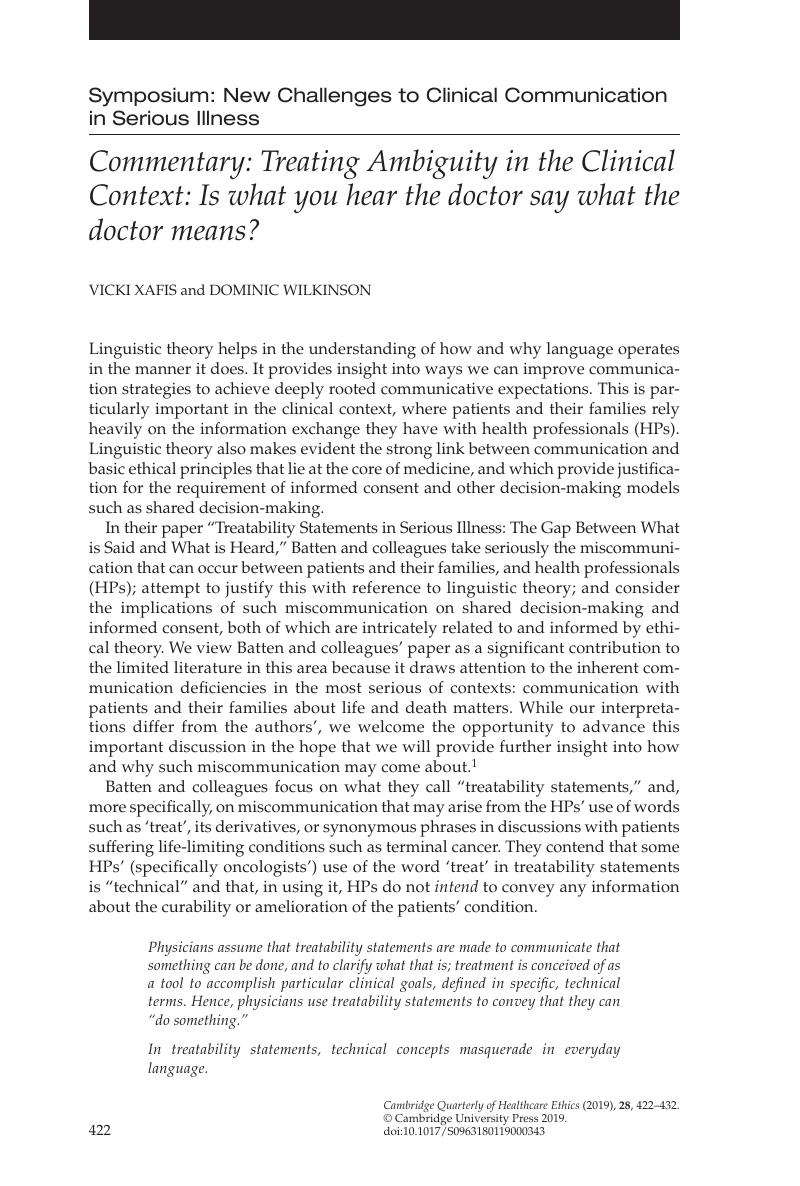Article contents
Commentary: Treating Ambiguity in the Clinical Context: Is what you hear the doctor say what the doctor means?
Published online by Cambridge University Press: 12 July 2019
Abstract

- Type
- Symposium: New Challenges to Clinical Communication in Serious Illness
- Information
- Copyright
- Copyright © Cambridge University Press 2019
References
Notes
1. Batten, JN, Wong, BO, Hanks, WF, Magnus, DC. Treatability statements in serious illness: The gap between what is said and what is heard. Cambridge Quarterly of Healthcare Ethics 2019;28(3):394–404.CrossRefGoogle Scholar
2. See note 1, Batten et al. 2019.
3. Cambridge Dictionary [internet]. Cambridge University Press Cambridge. [Cited 19 Nov 2018]; available at https://dictionary.cambridge.org/dictionary/english (last accessed 14 Dec 2018).
4. COBUILD. University of Birmingham. Collins Cobuild English Language Dictionary. Sinclair J, ed., London: HarperCollins; 1993 (first published 1987).
5. Longman Language Activator: The World’s First Production Dictionary, Summers D, ed. 1993, Harlow, Essex, England: Longman.
6. Merriam-Webster Dictionary [internet]. [Cited 2018 Nov 19] available at https://www.merriam-webster.com/dictionary (last accessed 14 Dec 2018).
7. Oxford Advanced American Dictionary [internet]. [Cited 19 Nov 2018]; available at https://www.oxfordlearnersdictionaries.com/definition/american_english/ (last accessed 14 Dec 2018).
8. Oxford Advanced Learner’s Dictionary [internet]. [Cited 19 Nov 2018]; available at https://www.oxfordlearnersdictionaries.com/definition/english/ (last accessed 14 Dec 2018).
9. Edward, F, David, B, Peter, C. Language: Its Structure and Use. Second ed., Sydney: Harcourt Brace; 1997.Google Scholar
10. Hancock, K, Clayton, JM, Parker, SM, Walder, S, Butow, PN, Carrick, S, Tattersall, MH. Truth-telling in discussing prognosis in advanced life-limiting illnesses: A systematic review. Palliative Medicine 2007;21(6):507–17.CrossRefGoogle ScholarPubMed
11. See note 10, Hancock et al. 2007.
12. Davies, BL. Grice’s Cooperative Principle: Meaning and rationality. Journal of Pragmatics 2007;39:2308–31.CrossRefGoogle Scholar
13. Grice, HP. Logic and conversation. In: Syntax and Semantics, Vol. 3: Speech Acts, Peter, C, Jerry, LM, eds., New York: Academic Press; 1975:45.Google Scholar
14. See note 13, Grice 2007, at 45.
15. See note 1, Batten et al. 2019.
16. Xafis, V, Watkins, A, Wilkinson, D. Death talk: Basic linguistic rules and communication in perinatal and paediatric end-of-life discussions. Patient Education and Counseling 2016;99(4):555–61.CrossRefGoogle ScholarPubMed
17. See note 16, Xafis et al. 2016.
18. Xafis, V, Wilkinson, D, Sullivan, J. What information do parents need when facing end-of-life decisions for their child? A meta-synthesis of parental feedback. BioMedCentral Palliative Care 2015;14(1):1–11.Google Scholar
19. See note 1, Batten et al. 2019.
20. See note 18, Xafis et al. 2015.
21. Parker, SM, Clayton, JM, Hancock, K, Walder, S, Butow, PN, Carrick, S, Tattersall, MHN. A systematic review of prognostic/end-of-life communication with adults in the advanced stages of a life-limiting illness: Patient/caregiver preferences for the content, style, and timing of information. Journal of Pain and Symptom Management 2007;34(1):81–93.CrossRefGoogle Scholar
22. Walczak, A, Butow, PN, Davidson, PM, Bellemore, FA, Tattersall, MHN, Clayton, JM, Epstein, RM. Patient perspectives regarding communication about prognosis and end-of-life issues: How can it be optimised? Patient Education and Counseling 2013;90(3):307–14.CrossRefGoogle ScholarPubMed
23. Fallowfield, LJ, Jenkins, VA, Beveridge, HA. Truth may hurt but deceit hurts more: Communication in palliative care. Palliative Medicine 2002;16(4):297–303.CrossRefGoogle ScholarPubMed
- 3
- Cited by




